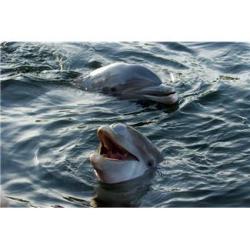Source Institutions
Source Institutions
Add to list Go to activity
Activity link broken? See if it's at the internet archive

In this lab, learners experience how dolphins and other echolocating animals use their senses to locate and identify objects without using their sense of sight. To simulate this process, learners work in pairs (one blindfolded and one using a water gun), shoot at targets, listen to the sound of the water hitting the target, and attempt to guess the target's shape and material. Learners also analyze how distance affects echolocation and how tuna nets impact dolphins' ability to echolocate.
- 10 to 30 minutes
- 45 to 60 minutes
- $10 - $20 per group of students
- Ages 14 - 18
- Activity, Experiment/Lab Activity, Lesson/Lesson Plan, Simulation
- English
Quick Guide
Materials List (per group of students)
- Blindfold
- Super Soaker 100
- Plastic triangle target
- Plastic circle target
- Plastic square target
- Metal triangle target
- Metal circle target
- Metal square target
- Wooden triangle target
- Wooden circle target
- Wooden square target
- Fish net target
- Paper towels
Subjects
-
Life Sciences
-
Diversity of Life
- Animals
-
Human Senses and Perception
- Hearing
-
Diversity of Life
-
Mathematics
-
Data Analysis and Probability
- Data Analysis
- Data Collection
- Measurement
-
Data Analysis and Probability
-
Physical Sciences
-
Vibration and Waves
- Sound
-
Vibration and Waves
-
The Nature of Science
-
The Scientific Process
- Conducting Investigations
- Gathering Data
- Formulating Explanations
- Communicating Results
-
The Scientific Process
Informal Categories
- Animals
- Toys
Audience
To use this activity, learners need to:
- see
- read
- hear
- be mobile
- touch
Learning styles supported:
- Involves teamwork and communication skills
- Involves hands-on or lab activities
Other
This resource is part of:
Access Rights:
- Free access
By:
- Mills, Donald
Rights:
- All rights reserved, Access Excellence @ the National Health Museum, 2009
